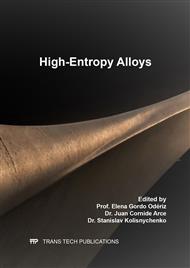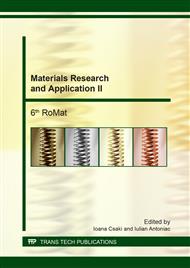p.9
p.15
p.20
p.26
p.34
p.39
p.45
p.53
p.69
Study on Wear Resistance FeNiCrMnAl High Entropy Alloy - Mechanical Properties
Abstract:
Traditional alloys is based on a single element called matrix and to improve some mechanical properties (strength, ductility, strength) are added and other metallic elements in the system. High entropy alloys have become a field of increasingly explored in the world of materials. Excellent mechanical properties obtained of the high entropy alloys recommend them to be from year to year as investigated. In the last decade more than 500 high entropy alloys journal and conference papers have been published [1]. High entropy alloys are alloys who have in their composition 5 to 13 metal elements and the concentration of each component is between 5% and 35%. These elements in the composition of high entropy alloys are divided into elements of minority and majority elements. They are called minority elements because their molar fraction is less than 5%. High entropy alloys have mixing entropy higher than traditional alloys, ΔScons≥1.61R (R = 8.314 J / (mol • K)) [1]. High entropy alloy have been obtained in the laboratory of Science and Materials Engineering faculty from Iasi using a medium frequency induction furnace with 8000 Hz. Because they have excellent mechanical properties high entropy alloys can be used in various fields with high wear and corrosion degree or electronic, magnetic applications [1]. In this work we selected pure metallic elements like: Fe, Ni, Cr, Mn and Al. The quantity of alloy developed varied between 0.5 and 1.5 kg. Metal load necessary for the preparation of metal alloys were formed technical grade, industrial accessible prices and satisfying. Friction and wear rezistance were studies by using a reciprocating sliding test machine , in a pin on disk configuration, using aluminum as counter face.In this paper it investigated the wear resistance of high entropy alloys obtained, microstructure and their mechanical properties.
Info:
Periodical:
Pages:
34-38
Citation:
Online since:
August 2017
Authors:
Keywords:
Price:
Сopyright:
© 2017 Trans Tech Publications Ltd. All Rights Reserved
Share:
Citation:



